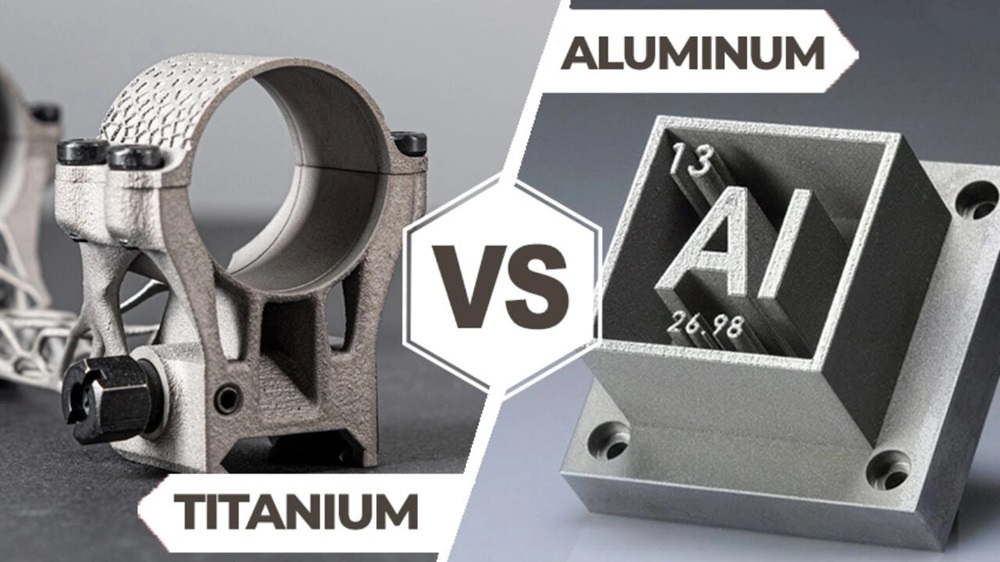
Titanium vs aluminum strength plays a key role in how engineers and designers choose materials for metal 3D printing. The market for titanium 3D printing shows huge promise – from $214 million in 2023 to $1.4 billion by 2032. These numbers make it crucial to understand both materials well. Titanium proves much stronger with ultimate tensile strength up to 1170 MPa. Aluminum reaches only 310 MPa in comparison.
Titanium might be stronger, but the choice between these metals depends on several key factors. The strength comparison needs to look at how dense each metal is – titanium weighs in at 4.5 g/cm³, while aluminum stays lighter at 2.7 g/cm³. On top of that, the price makes a big difference: titanium costs about 20 USD per kg, but aluminum only costs 2 USD per kg. The strength-to-weight ratios make titanium the best pick for tasks that need reliable performance. Both metals work well in 3D printing, but titanium’s very high melting point of 1650-1670°C creates special challenges. Aluminum melts at a much lower 582-652°C. This piece gets into which metal wins for 3D printing by looking at how they perform, what they need for processing, how they work in real life, and what they cost.
Core Mechanical Differences
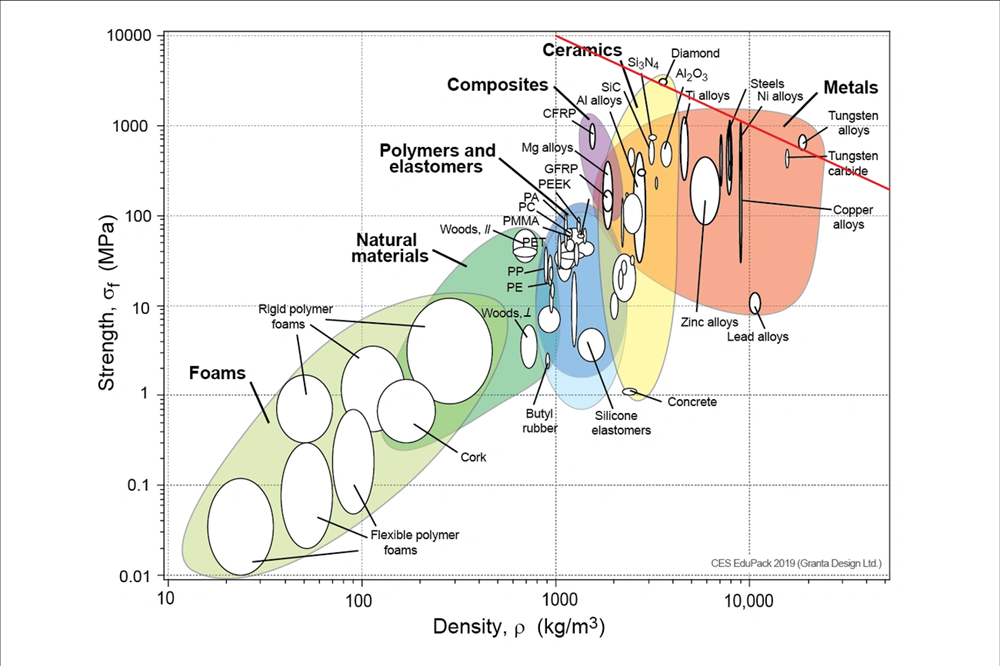
A close look at mechanical properties reveals clear differences between these two metals through their core strength characteristics. Engineers can select the best material for specific 3D printing applications by understanding these key differences.
Ultimate Tensile Strength: Titanium vs Aluminum
The raw strength numbers show a dramatic gap between these metals. Ti-6Al-4V (Grade 5) titanium alloy delivers ultimate tensile strength ranging from 1000 to 1190 MPa. This makes it about three times stronger than 6061-T6 aluminum, which reaches just 310 MPa. Such a striking difference lets designers create titanium components with thinner walls while maintaining structural integrity.
Pure titanium shows tensile strength around 434 MPa, which outperforms pure aluminum at just 90 MPa. Yield strength tells a similar story – titanium alloys reach 910-1110 MPa while aluminum stays at 270-276 MPa.
Elastic Modulus and Shear Modulus Comparison
These metals show notable differences in stiffness, another crucial mechanical property:
| Property | Titanium (Ti-6Al-4V) | Aluminum (6061-T6) |
|---|---|---|
| Elastic Modulus | 110-116 GPa | 69-72 GPa |
| Shear Modulus | 40-44 GPa | 26 GPa |
Titanium components resist deformation 60% better under similar loads. This allows designers to create lighter structures for high-stress applications. But this higher stiffness brings trade-offs – titanium’s reduced flexibility might not suit applications that need vibration damping.
Impact Resistance and Fatigue Life
Titanium’s most impressive feature might be its extraordinary fatigue resistance. Ti-6Al-4V shows fatigue strength between 530-630 MPa, about five times greater than aluminum’s 95-105 MPa. This huge difference explains why aerospace components that face millions of load cycles often use titanium.
Titanium also leads in impact resistance. Research shows titanium-based laminates absorb impacts better. The metal layers can absorb over 90% of impact energy through membrane deformation. This exceptional durability makes titanium perfect for critical components where failure could be catastrophic.
Aluminum’s fatigue performance drops at temperatures above 250°F (121°C). Titanium keeps its mechanical properties up to 550°F (288°C). This thermal stability and superior impact resistance make titanium the obvious choice for high-stress, high-temperature applications, despite costing more.
Adding alloying elements improves both metals’ performance. Mixing aluminum with copper and zinc can lift its strength to 570-690 MPa. But even these improved formulations can’t match titanium’s impressive mechanical profile.
3D Printing Process Suitability
Titanium and aluminum have carved their own niches in the digital world of additive manufacturing. Each metal demands specific processing based on its physical properties.
Can You 3D Print with Titanium and Aluminum?
Yes, it is possible to 3D print both metals, though they need different alloy formulations that work best for additive processes. Ti-6Al-4V (Ti-64) stands out as the most accessible titanium alloy in metal 3D printing. This alloy delivers exceptional mechanical strength and fights corrosion effectively. AlSi10Mg is the go-to choice for aluminum printing, where silicon and magnesium boost its printability.
These materials shine in different industries. Ti-64 works great for aerospace parts, medical implants, and high-performance car components. AlSi10Mg proves its worth in lightweight structural parts. Its properties are a big deal as it means that they surpass die-cast versions, though it shows lower elongation when breaking.
SLM and EBM for Titanium vs Cold Spray for Aluminum
Powder Bed Fusion (PBF) technologies are the foundations of titanium printing, with Selective Laser Melting (SLM) and Electron Beam Melting (EBM) leading the way. SLM uses a laser beam that melts titanium powder at temperatures up to 1,600°C. EBM takes a different approach by using an electron beam inside a vacuum chamber.
Cold Spray technology gives aluminum printing an edge beyond these standard methods. The process shoots metal particles at high speeds without melting them. This approach works perfectly with temperature-sensitive and oxygen-sensitive materials like aluminum. Cold Spray can deposit up to 20 kg/hour and handles aluminum without oxidation issues. This makes it a great way to get large aluminum components.
Build Speed and Layer Resolution Differences
The processing parameters show key differences:
| Parameter | SLM (Titanium) | EBM (Titanium) | Cold Spray (Aluminum) |
|---|---|---|---|
| Layer Thickness | 20-40 μm | 50-100 μm | N/A (direct deposition) |
| Resolution | 50-80 μm | 100+ μm | 6mm spot size |
| Build Speed | 10-30 cm³/h | 55-80 cm³/h | Up to 100g/minute |
| Surface Finish (Ra) | 5-15 μm | 20-50 μm | Requires post-processing |
SLM excels at creating detailed titanium components that need precision, such as medical implants and surgical tools. EBM produces larger titanium aerospace components with higher productivity but rougher resolution. Cold Spray helps create bigger aluminum parts quickly and saves substantial material compared to traditional manufacturing.
The final choice between these processes depends on what you need. You must balance component size, geometric complexity, and surface finish quality against how fast you can produce parts and what they cost.
Material Behavior in Real-World Use
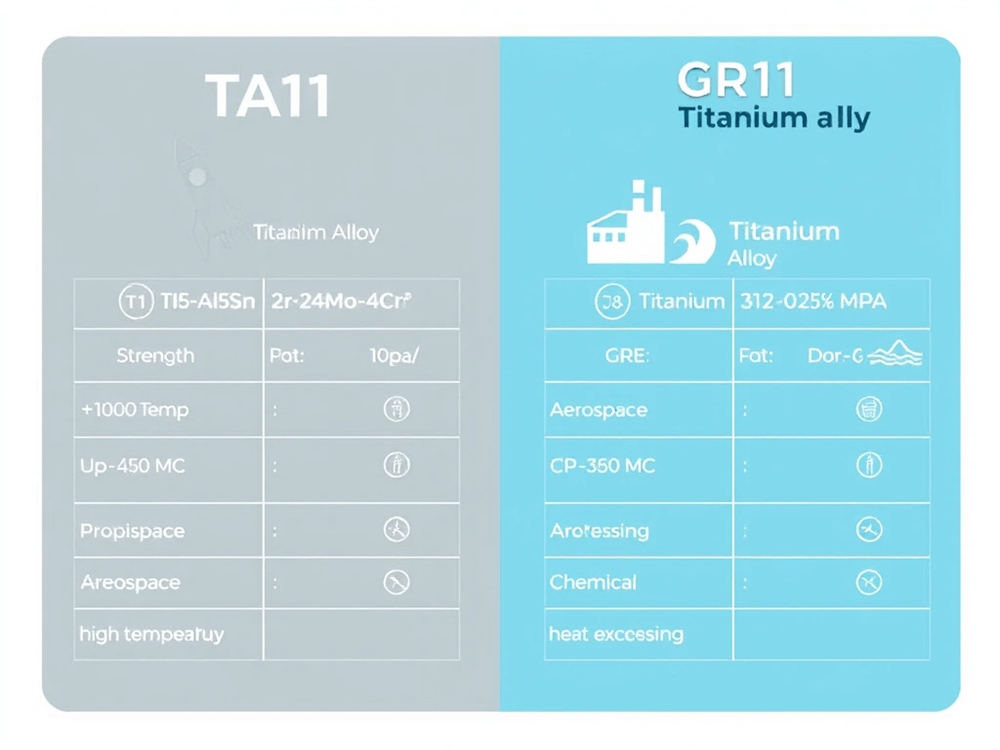
Titanium and aluminum show key differences in how they work in ground applications, beyond just their mechanical properties. These differences play a big role in choosing the right material for specific industries.
Heat Resistance in Aerospace and Automotive
The way these metals handle heat creates clear boundaries for their use. Titanium stays strong at temperatures up to 550°C, while aluminum holds its structure only up to 250°C. This is a big deal as it means that titanium works better in high-heat situations.
Modern jet engines use titanium alloys for about 40% of their weight. Titanium’s strength at high temperatures makes it perfect for turbine jets and engine exhaust outlets. The metal’s high melting point also helps it handle severe heat stress.
The automotive world has embraced titanium’s heat-handling advantages. Bugatti used SLM technology to create titanium brake calipers that weigh 40% less than regular aluminum ones and handle heat better. This mix of light weight and heat resistance makes titanium valuable for high-performance cars.
Corrosion Resistance in Marine and Medical
Both metals create protective oxide layers, but they fight corrosion differently. Titanium shows exceptional resistance to corrosion, especially when exposed to harsh chemicals like dichromic acid, perchloric acid, and nitric acid. This protection comes from titanium’s stable protective film.
Ti-6Al-4V and other titanium alloys work great in salty environments, which makes them ideal for marine use. Aluminum has its own protective layer, but it doesn’t guard against corrosion as well as titanium.
Medical equipment benefits from titanium’s resistance to bodily fluids. Research shows that CP Ti and Ti-6Al-4V perform better than other metals in biological environments. They show lower passive currents and resist breakdown better, without pitting, both in lab tests and in the body.
Biocompatibility: Titanium’s Edge in Implants
Titanium stands out most for its compatibility with the human body. The metal rarely triggers immune responses because it’s biologically inert. Its passive oxide film creates the right balance between corrosion resistance and reactivity.
Titanium is unique because it achieves “osseointegration,” where bone connects directly to the implant without soft tissue in between. This explains why titanium implants last so long, with a 97% success rate after 10 years and 75% after 20 years.
Medical professionals rely on titanium for orthopedic implants, dental work, and surgical tools. Research shows that bone screws and nails made from titanium alloys integrate into bone tissue over time. This proves how well titanium works with human tissue.
Cost Breakdown and Budget Fit
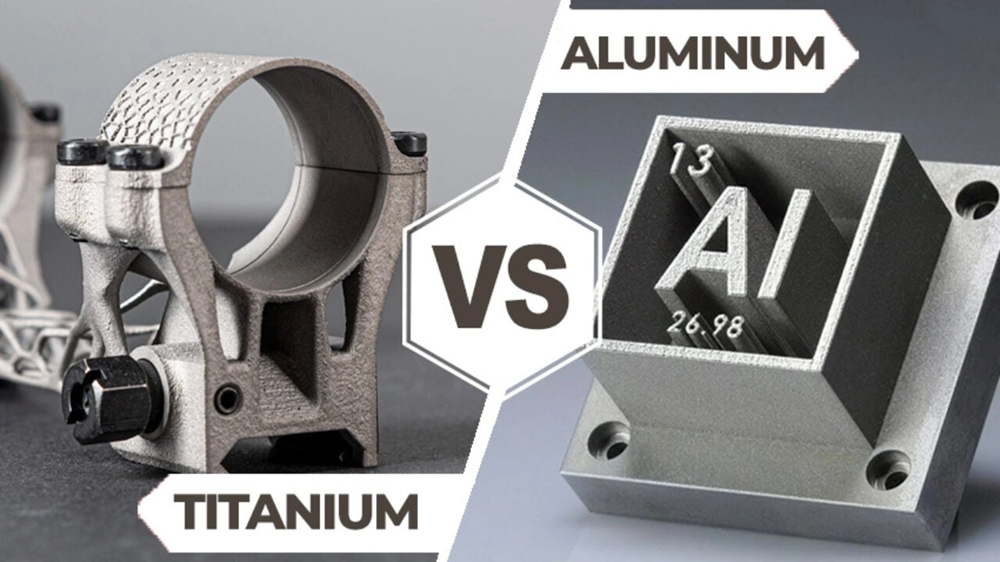
Money plays a decisive role in choosing between titanium and aluminum for metal 3D printing. Engineers must understand the cost breakdown to make smart decisions based on their project’s requirements and budget.
Titanium vs Aluminum Cost per kg
These metals have a huge price difference. Titanium costs a lot more – Ti-6AI-4V titanium alloy powder or pure Grade 2 titanium runs about $363 per kilogram. Aluminum alloys are nowhere near as expensive—AISi7 aluminum alloy powder costs around $94 per kg, and AISi10Mg comes in at about $98 per kg.
Nature explains this price gap. Aluminum makes up about 8% of Earth’s crust, and extraction is straightforward. Titanium only makes up 0.6% and we need complex chemical reactions and high-temperature reduction to process it. This creates a price difference of roughly 17.5x in raw materials.
Titanium 3D Printing Cost: Material + Machine + Labor
Raw material costs are just the start. The total cost of titanium 3D printing includes many more important factors:
- Equipment Investment: Professional metal 3D printers cost between $100,000 and $500,000
- Machine Operation: Titanium printing rates range from $80 to $150 per hour
- Post-Processing Requirements: Titanium parts just need extensive post-processing, including stress relief, heat treatment, and surface finishing
A moderately complex titanium part (around 100 cm³) costs between $800 and $1,500 per unit with simple post-processing. The complete process takes 7+ business days from design review through printing, heat treatment, and quality inspection.
When Aluminum Offers Better Value
Aluminum becomes more economical in several cases, especially when:
- Budget Constraints Exist: Aluminum’s lower cost structure gives you an affordable option when money is tight
- Production Volume Is High: Aluminum works better when scaling up production
- Extreme Strength Isn’t Critical: Projects that don’t need the highest strength-to-weight ratio can use aluminum. It offers 30% higher strength-to-weight ratio than stainless steel at 50-70% lower cost than titanium
Aluminum stands out as the most economical metal for 3D printing. Titanium still proves valuable through fuel savings in transportation and longer service life, which can justify its premium in specialized applications.
Choosing the Right Metal for Your Project
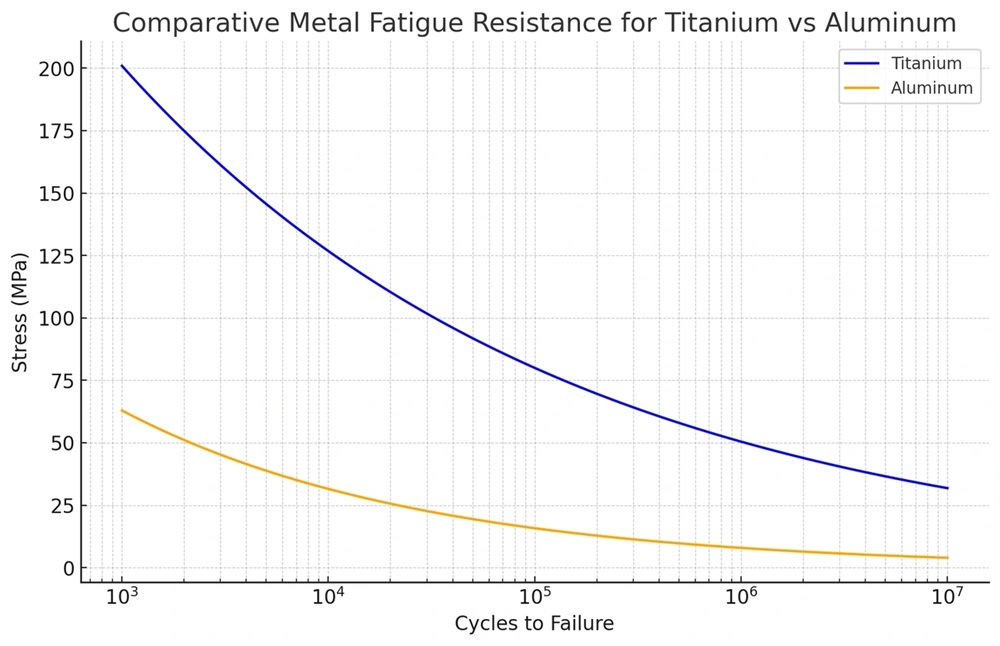
Choosing between titanium and aluminum means weighing several factors against your project’s needs. The best choice depends on your specific application rather than one material being better than the other.
When Strength-to-Weight Ratio Matters Most
Titanium stands out in critical situations where weight matters and you can’t compromise on strength. Its combination of high strength and low density makes it perfect for high-performance applications like aerospace structural components and medical implants. Titanium matches steel’s strength but weighs 45% less, making it ideal for applications where performance matters more than cost. This advantage is vital for aerospace engine parts, turbine blades, and structural supports where failure isn’t an option.
When Budget and Speed Are Priorities
Aluminum proves to be the most budget-friendly metal for 3D printing when money is tight. Projects that need high production volumes or don’t need extreme strength work well with aluminum, which costs 50-70% less than titanium. So, aluminum brings great value through its material efficiency and creates less waste than traditional manufacturing methods. The material’s lower melting point (460-670°C compared to titanium’s 1660°C) speeds up production and uses less energy.
Design Complexity and Post-Processing Needs
These materials need different levels of post-processing. Titanium parts need extensive treatment to get the right properties. SLM printing works better for small, detailed parts with smooth surfaces—like medical devices. EBM is better suited for larger titanium components where resolution isn’t as important. Aluminum, however, is easier to machine during post-processing. This means complex geometries that need lots of post-processing might be simpler to produce with aluminum.
Industry-Specific Recommendations
- Aerospace: Titanium shines in landing gears, fasteners, frames, and other critical structural parts where its strength-to-weight ratio justifies the higher cost
- Medical: Nothing beats titanium for implants because of its biocompatibility and osseointegration properties
- Automotive: Aluminum works best for most applications, while titanium is reserved for high-performance parts in luxury or racing vehicles
- Marine: Titanium’s superior corrosion resistance makes it the better choice for saltwater environments, even with its higher price tag
Comparison Table
| Characteristic | Titanium (Ti-6Al-4V) | Aluminum (6061-T6/AlSi10Mg) |
|---|---|---|
| Mechanical Properties | ||
| Ultimate Tensile Strength | 1000-1190 MPa | 310 MPa |
| Elastic Modulus | 110-116 GPa | 69-72 GPa |
| Shear Modulus | 40-44 GPa | 26 GPa |
| Fatigue Strength | 530-630 MPa | 95-105 MPa |
| Physical Properties | ||
| Density | 4.5 g/cm³ | 2.7 g/cm³ |
| Melting Point | 1650-1670°C | 582-652°C |
| Max Operating Temperature | 550°C | 250°C |
| 3D Printing Parameters | ||
| Common Printing Methods | SLM, EBM | SLM, Cold Spray |
| Layer Thickness (SLM) | 20-40 μm | Not specified |
| Surface Quality | 5-15 μm (SLM) | Needs post-processing |
| Build Rate | 10-30 cm³/h (SLM) | Up to 100g/minute (Cold Spray) |
| Cost Factors | ||
| Material Cost | ~$363/kg | ~$94-98/kg |
| Operation Cost | $80-150/hour | Not specified |
| Key Applications | ||
| Main Industries | Aerospace, Medical, High-performance automotive | Automotive, General structural components |
| Resistance to Corrosion | Outstanding | Good but limited compared to titanium |
| Compatibility with Living Tissue | Excellent (97% success at 10 years) | Not mentioned |
Conclusion
Titanium and aluminum each shine in different ways when it comes to 3D printing applications. Titanium stands out with its mechanical strength that’s almost triple that of aluminum. It works amazingly well in tough conditions thanks to its heat resistance, protection from corrosion, and unique compatibility with living tissue. These qualities make it perfect for aerospace parts, medical implants, and critical applications where failure isn’t an option.
In spite of that, aluminum has its own strong points that explain why it’s so popular. It costs about 17.5 times less than titanium, making it the smart choice for many projects. Aluminum’s lighter weight, quicker printing speed, and easier finishing work often make it the best pick when budget matters or extreme strength isn’t crucial.
These metals are changing how manufacturing works through additive processes. Titanium needs higher temperatures and special equipment to process, but the final parts perform incredibly well in the harshest conditions. While not as strong, aluminum provides great conductivity, easy machining, and budget-friendly benefits that make it essential in many industries.
Choosing between these metals comes down to balancing what you need versus what’s practical. Engineers weigh titanium’s amazing strength-to-weight ratio and toughness against aluminum’s cost savings and easier processing. Aerospace and medical uses usually justify titanium’s higher price, while regular structural parts and budget-conscious projects do better with aluminum.
Instead of picking an overall winner, smart material selection needs careful review of what the application needs, what you can spend, and how well it must perform. Each metal shines in its own way, and knowing these subtle differences helps engineers pick the right material for their additive manufacturing projects.
Key Takeaways
Understanding the fundamental differences between titanium and aluminum helps engineers make informed material choices for 3D printing projects based on performance requirements and budget constraints.
• Titanium delivers 3x stronger performance: With ultimate tensile strength reaching 1190 MPa versus aluminum’s 310 MPa, titanium excels in high-stress applications requiring maximum durability.
• Aluminum offers 17x lower material costs: At ~$94/kg compared to titanium’s ~$363/kg, aluminum provides excellent value for budget-conscious projects without extreme strength requirements.
• Temperature resistance creates clear application boundaries: Titanium maintains strength up to 550°C while aluminum degrades above 250°C, making titanium essential for aerospace and high-heat environments.
• Biocompatibility makes titanium irreplaceable for medical use: With 97% implant success rates at 10 years and unique osseointegration properties, titanium remains the gold standard for medical implants.
• Processing complexity varies significantly: Titanium requires specialized high-temperature equipment and extensive post-processing, while aluminum offers faster printing and easier machining for quicker turnaround.
The choice ultimately depends on balancing performance demands against practical constraints—titanium for mission-critical applications where failure isn’t acceptable, aluminum for cost-effective solutions where moderate strength suffices.
FAQs
Q1. How does the strength of titanium compare to aluminum for 3D printing? Titanium is significantly stronger than aluminum, with an ultimate tensile strength of 1000-1190 MPa compared to aluminum’s 310 MPa. This makes titanium about three times stronger, ideal for high-stress applications where durability is critical.
Q2. What is the cost difference between titanium and aluminum for 3D printing? Titanium is considerably more expensive, costing around $363 per kilogram, while aluminum alloys cost approximately $94-98 per kilogram. This makes aluminum about 17 times less expensive than titanium for raw materials.
Q3. Which metal is better suited for high-temperature applications? Titanium outperforms aluminum in high-temperature environments. It can maintain its strength up to 550°C, while aluminum typically degrades above 250°C. This makes titanium the preferred choice for aerospace and other high-heat applications.
Q4. How do titanium and aluminum compare in terms of corrosion resistance? Both metals form protective oxide layers, but titanium demonstrates superior corrosion resistance, especially in highly oxidizing environments. This makes titanium particularly valuable in marine applications and medical implants where corrosion resistance is crucial.
Q5. What are the key factors to consider when choosing between titanium and aluminum for a 3D printing project? The choice depends on balancing performance requirements with practical constraints. Consider factors such as strength-to-weight ratio, budget, production speed, operating temperature, corrosion resistance, and industry-specific needs. Titanium is ideal for critical, high-performance applications, while aluminum offers cost-effectiveness for projects where moderate strength suffices.

